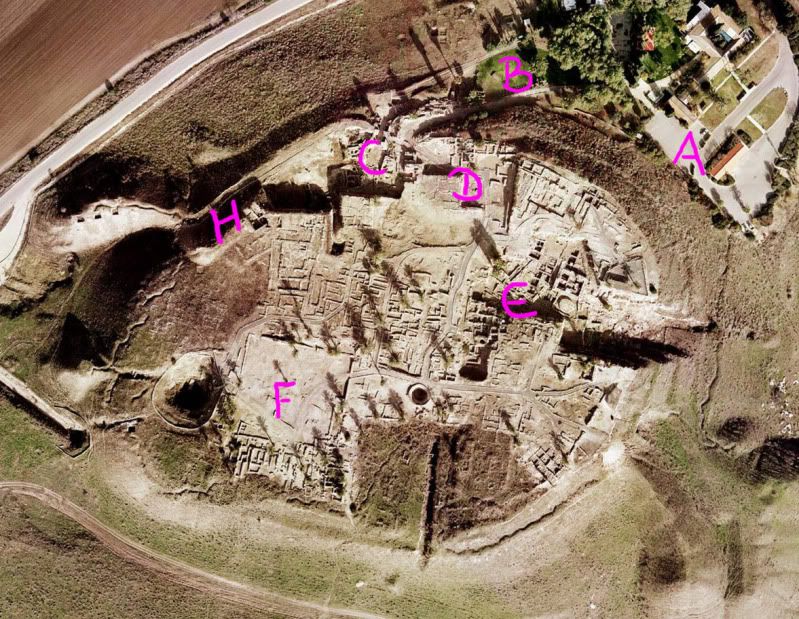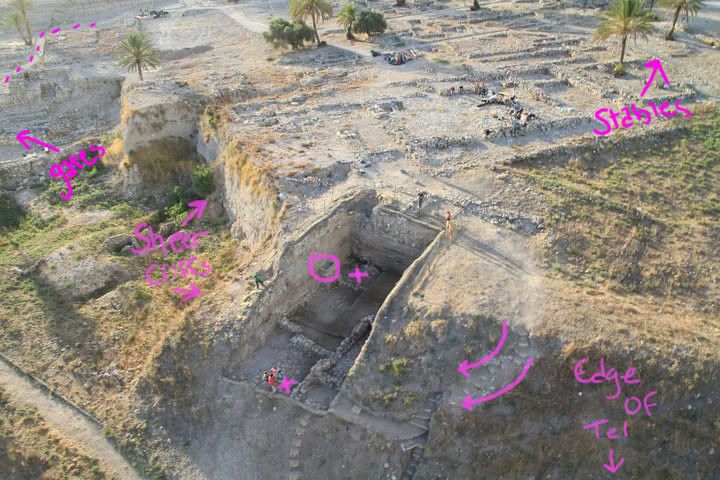Megiddo Adventures
GMail is being a jerk, so I'm putting this here.
Aaah, I meant to do this ages ago. Take my precious
knowledge!
Okay this is Megiddo:

A is where your bus will pull up. There's a little museum thing; I
don't know if you'll visit it. I didn't find it very interesting the
one time we went inside, but there's like a model I think.
You'll walk along a little path thing past B, which is where we
ate breakfast every day, more or less. Exciting!
Then you'll walk up the tel through C, which is where the
"Solomonic" chambered gates are. THESE ARE almost certainly NOT
Solomonic! They probably date to the following Omride period. So think
of Ahab and Jezebel while you're there. (Right before you go through
the gates, you might see a little trail off to the right side,
probably blocked off by a wire or fence. That was the way I went to my
dig area.)
The you'll walk by or through D, which is the first set of stables
and a palace that they're reconstructing. Prof Cline doesn't think the
palace is accurate; also it and the stables are from a different
period. Finally, they're building the reconstruction over half of an
enormous bronze age temple, so we won't be able to excavate it now.
Boo.
I stuck the letter E kind of in the middle of Area J, where Oren,
Christine, and everyone else I knew dug. You'll know it because it's a
lot lower than most of the tel; they were digging Bronze age stuff
while the rest of us were on Iron. This area includes a huge round
stone altar. There's no evidence of human sacrifices, but many animal
sacrifices were carried out. Also in this area is the huge bronze age
temple partly obscured by the palace reconstruction I mentioned
earlier. This thing is HUGE; it's sometimes called the Megaron temple
after Greek temples. The most noticeable remnants, I think, are the
large black pillar bases. They're made of basalt, I think, which is
much harder than the other stone used in construction at Megiddo, so
their shape has survived very well. Also found here were flagstones
carved with animals, but they've been removed for preservation.
Then you'll go by other things, including probably a well and a
grain storage thing, but I don't really remember much there. I stuck
letter F in the second stables. There are some fairly tacky horse and
chariot sculptures here. Definitely take a picture on the chariot. The
stables have partially reconstructed. There are some inaccuracies, but
I don't really remember what they are. I think some of the troughs
have been put in backward (horses leave cribbing marks on the stone;
they should be on the inside of the troughs) and there's no good way
for the horses to get out? Also, the actual stables were more to the
right if you're facing them.
I think the entrance to the water tunnel is in this general area,
but I don't remember.
Fun! But, we have a problem. TOURISTS *NEVER* go by Area H, marked
cleverly on this map by the letter H. (Yes, I skipped G, what of it.)
If you can, go over and visit!

This is a better picture of Area H. I've marked some orienting
features that you might be able to see if you squint. The X's are
where I dug for the most part. I circled this awesome stone basin
that's jutting out of the wall. We built some stairs at the start of
the session in order to get into the dig area; I don't know if they're
still there. You might be able to walk down. Also, I don't know if
there'll be a tarp overhead. Probably not, but it's hard to say.
Don't you feel EDUCATED now? Also, keep an eye out for the smaller
hills surrounding the tel; those are all fill piles. A fragment of the
Epic of Gilgamesh was found in one of the fill piles over by Area J,
because Schumacher was a loser who didn't know how to excavate
properly.